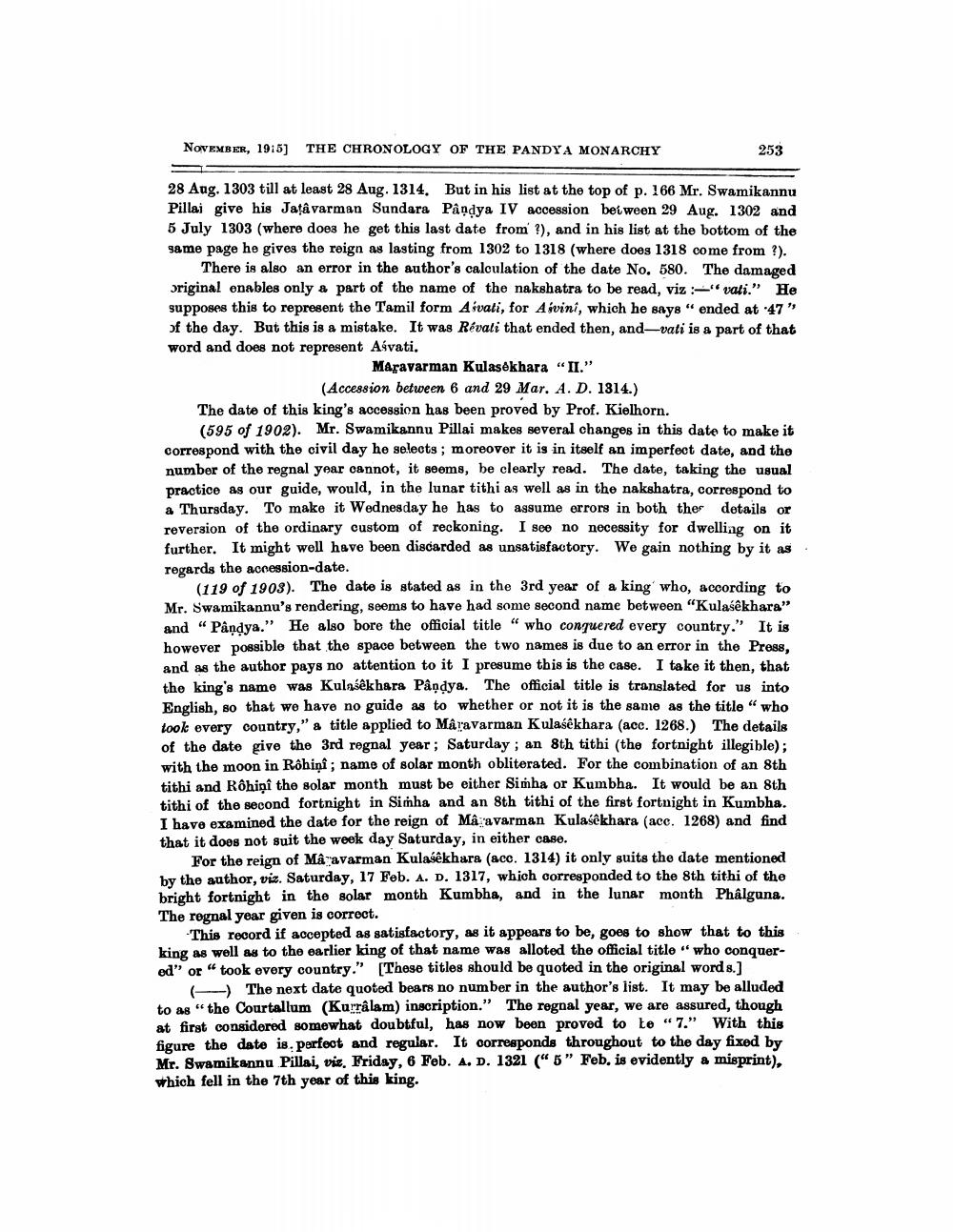________________
NOVEMBER, 1915) THE CHRONOLOGY OF THE PANDYA MONARCHY
253
28 Aug. 1303 till at least 28 Aug. 1314. But in his list at the top of p. 166 Mr. Swamikannu Pillai give his Jatâ varman Sundara Pandya IV accession between 29 Aug. 1302 and 5 July 1303 (where does he get this last date from ?), and in his list at the bottom of the same page he gives the reign as lasting from 1302 to 1318 (where does 1318 come from?).
There is also an error in the author's calculation of the date No. 580. The damaged original enables only & part of the name of the nakshatra to be read, viz "vati." He supposes this to represent the Tamil form Aivati, for Asvini, which he says " ended at 47" of the day. But this is a mistake. It was Revali that ended then, and—vati is a part of that word and does not represent Aývati.
Maravarman Kulasekhara “II."
(Accession between 6 and 29 Mar. A. D. 1814.) The date of this king's accession has been proved by Prof. Kielhorn.
(595 of 1902). Mr. Swamikannu Pillai makes several changes in this date to make it correspond with the civil day he selects; moreover it is in itself an imperfect date, and the number of the regnal year cannot, it seems, be clearly read. The date, taking the usual practice as our guide, would, in the lunar tithi as well as in the nakshatra, correspond to a Thursday. To make it Wednesday he has to assume errors in both ther details or reversion of the ordinary custom of reckoning. I see no necessity for dwelling on it further. It might well have been discarded as unsatisfactory. We gain nothing by it as regards the accession-date.
(119 of 1903). The date is stated as in the 3rd year of a king who, according to Mr. Swamikannu's rendering, seems to have had some second name between "Kulašêkhara" and “ Påndya." He also bore the official title " who conquered every country." It is however possible that the space between the two names is due to an error in the Press, and as the author pays no attention to it I presume this is the case. I take it then, that the king's name was Kulašêkhara Pandya. The official title is translated for us into English, so that we have no guide as to whether or not it is the same as the title “who tooke every country," a title applied to Maravarman Kulasekhara (acc. 1268.) The details of the date give the 3rd regnal year; Saturday; an 8th tithi (the fortnight illegible); with the moon in Röhiņi; name of solar month obliterated. For the combination of an 8th tithi and Rôhiņi the solar month must be either Simha or Kumbha. It would be an 8th tithi of the second fortnight in Simha and an 8th tithi of the first fortnight in Kumbha. I have examined the date for the reign of Mâ avarman Kulasekhara (acc. 1268) and find that it does not suit the week day Saturday, in either case.
For the reign of Mâravarman Kulasekhara (acc. 1314) it only suits the date mentioned by the author, viz. Saturday, 17 Feb. A. D. 1317, which corresponded to the 8th tithi of the bright fortnight in the solar month Kumbha, and in the lunar month Phâlguna. The rognal year given is correct.
This record if accepted as satisfactory, as it appears to be, goes to show that to this king as well as to the earlier king of that name was alloted the official title " who conquered" or " took every country." These titles should be quoted in the original words.]
( -) The next date quoted bears no number in the author's list. It may be alluded to as "the Courtallum (Kurrâlam) inscription." The regnal year, we are assured, though at first considered somewhat doubtful, has now been proved to te “7." With this figure the date is perfect and regular. It corresponds throughout to the day fixed by Mr. Swamikannu Pillai, viz, Friday, 6 Feb. A. D. 1321 ("5" Feb, is evidently a misprint), which fell in the 7th year of this king.




